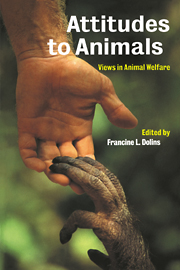Book contents
- Frontmatter
- Contents
- List of contributors
- Acknowledgements
- Part I Attitudes to animals
- Part II Animal awareness
- 4 The problem of animal subjectivity and its consequences for the scientific measurement of animal suffering
- 5 Environmental enrichment and impoverishment: neurophysiological effects
- 6 The behavioural requirements of farm animals for psychological well-being and survival
- 7 Personality and the happiness of the chimpanzee
- 8 Primate cognition: evidence for the ethical treatment of primates
- Part III Animal welfare
- Part IV Research and education
- Part V Epilogue: the future of wild animals
- Index
4 - The problem of animal subjectivity and its consequences for the scientific measurement of animal suffering
Published online by Cambridge University Press: 16 November 2009
- Frontmatter
- Contents
- List of contributors
- Acknowledgements
- Part I Attitudes to animals
- Part II Animal awareness
- 4 The problem of animal subjectivity and its consequences for the scientific measurement of animal suffering
- 5 Environmental enrichment and impoverishment: neurophysiological effects
- 6 The behavioural requirements of farm animals for psychological well-being and survival
- 7 Personality and the happiness of the chimpanzee
- 8 Primate cognition: evidence for the ethical treatment of primates
- Part III Animal welfare
- Part IV Research and education
- Part V Epilogue: the future of wild animals
- Index
Summary
Introduction
In modern, intensive housing systems, animals develop a wide variety of abnormal behaviour patterns. The general public has become increasingly aware of this. With growing urgency, people wonder what it must be like to be a hen in a battery cage, or a chimpanzee in a laboratory testing-pen. This formulation, to ask ‘what it feels like’ to be a certain animal, is how members of the general public perceive and formulate the problem of animal welfare. In day-to-day, common-sense interaction with animals, we use a type of language which is inherently subjectivistic, psychological in character; that is, a language which indicates that we share the world with active, independent individuals who have their own, personal perspective on that world, and accordingly, their own needs, feelings and thoughts. A technical philosophical term for such a kind of language, such a level of discourse, is ‘first-person-perspective’ (Nagel, 1986). To describe behaviour in first-person-perspective terms is to assess what that behaviour means from the other individual's perspective. For example, one may say an individual likes to do this, or wants to do that. Generally, animals are accepted into that level of discourse, assuming that they too have their particular point of view. We say the cat wants to get out of the house, or the pig expects to be fed. And, upon witnessing an animal's abnormal, highly repetitive behaviour, we presume that the animal finds its situation unmanageable and highly distressing.
- Type
- Chapter
- Information
- Attitudes to AnimalsViews in Animal Welfare, pp. 37 - 53Publisher: Cambridge University PressPrint publication year: 1999
- 7
- Cited by



